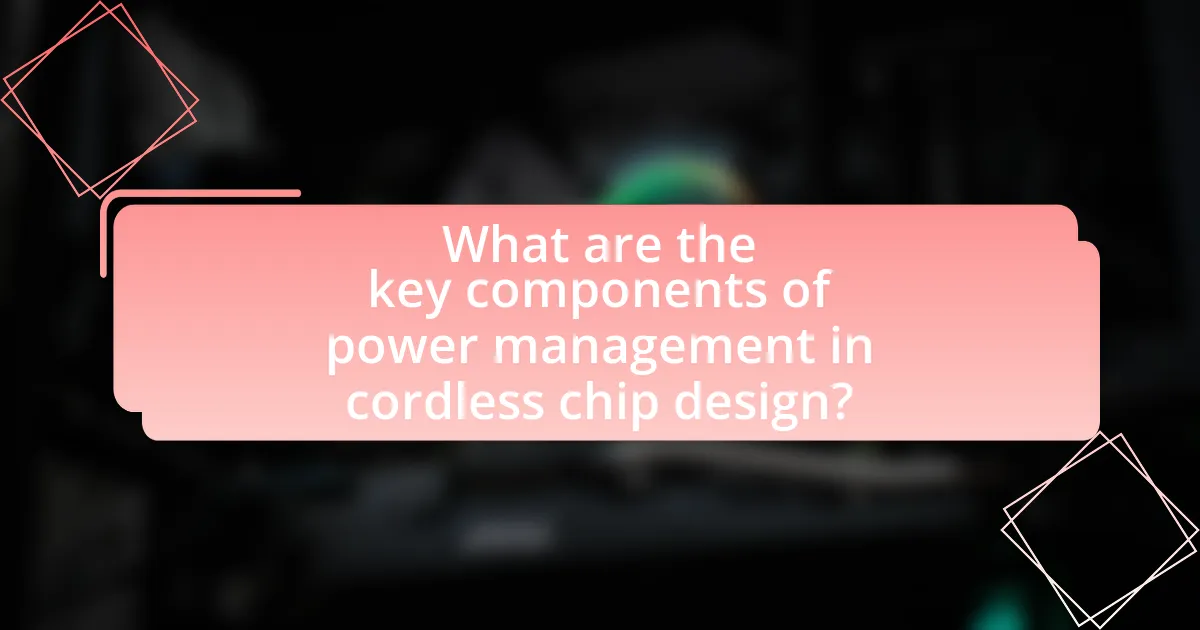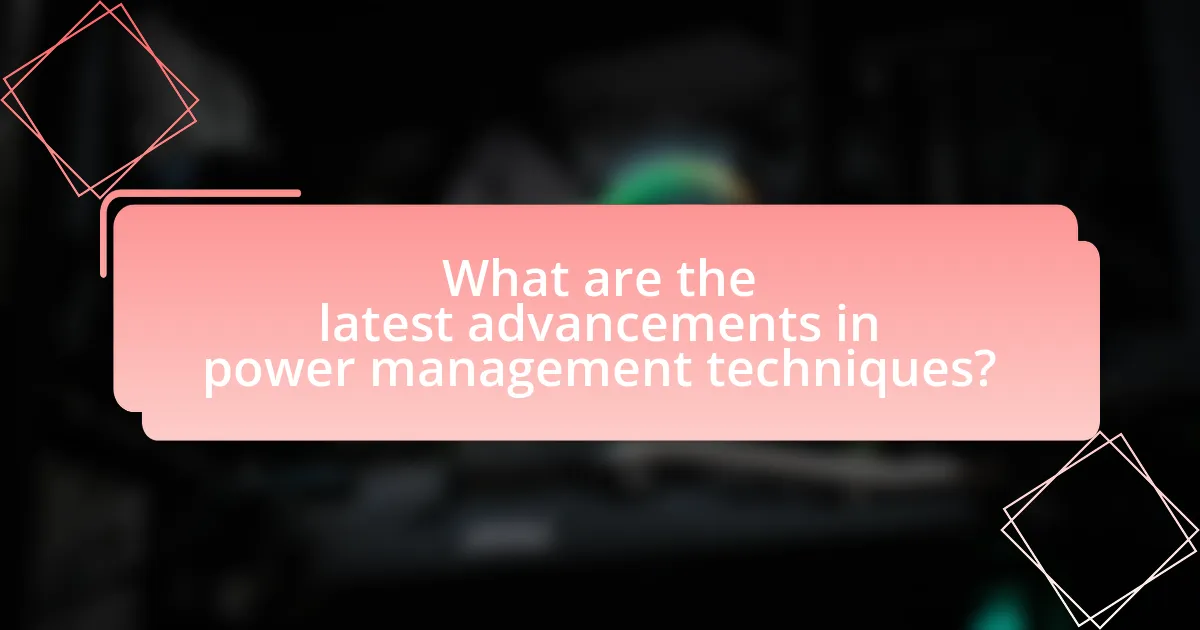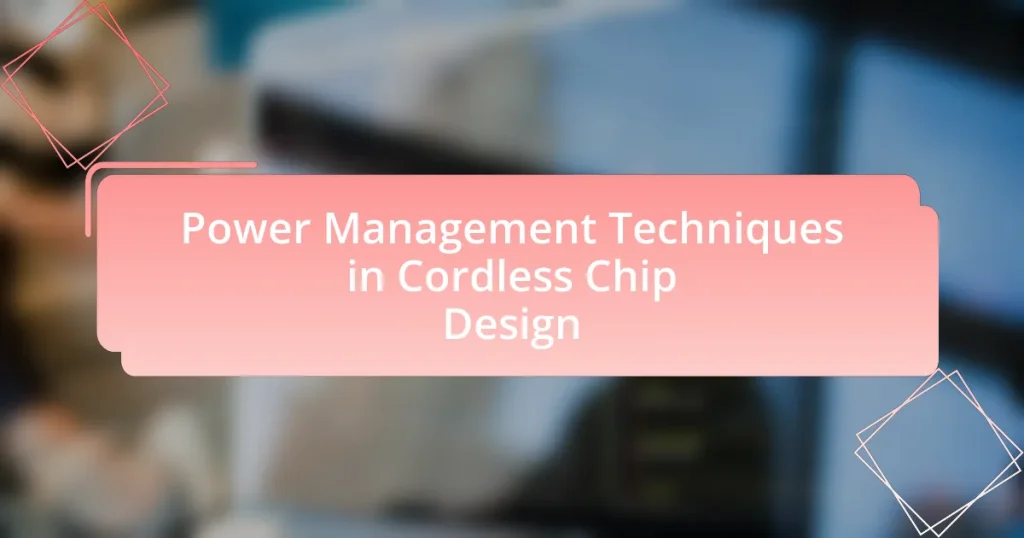Power management techniques in cordless chip design are critical for optimizing energy efficiency and enhancing battery life in portable devices. Key strategies include dynamic voltage scaling, power gating, and clock gating, which collectively reduce power consumption and minimize heat generation. The article explores how these techniques impact overall chip performance, the specific strategies commonly employed, and the challenges faced by designers without effective power management. Additionally, it discusses the role of voltage regulators, the significance of dynamic voltage and frequency scaling, and the latest advancements in energy harvesting and machine learning applications that further improve power management in modern chip designs.

What are Power Management Techniques in Cordless Chip Design?
Power management techniques in cordless chip design include dynamic voltage scaling, power gating, and clock gating. Dynamic voltage scaling adjusts the voltage levels according to the workload, which can reduce power consumption significantly; studies show that this technique can lead to power savings of up to 30%. Power gating involves shutting down sections of the chip that are not in use, effectively minimizing leakage currents, while clock gating disables the clock signal to inactive components, further conserving energy. These techniques are essential for enhancing battery life and overall efficiency in cordless devices.
How do these techniques impact overall chip performance?
Power management techniques significantly enhance overall chip performance by optimizing energy consumption and reducing heat generation. These techniques, such as dynamic voltage and frequency scaling (DVFS) and power gating, allow chips to adjust their power usage based on workload demands, leading to improved efficiency. For instance, DVFS can reduce power consumption by up to 50% during low-demand periods, which not only conserves energy but also prolongs battery life in portable devices. Additionally, effective power management minimizes thermal stress on components, thereby increasing reliability and performance longevity.
What specific power management strategies are commonly used?
Commonly used power management strategies include dynamic voltage and frequency scaling (DVFS), power gating, and clock gating. DVFS adjusts the voltage and frequency of a processor based on workload demands, which can lead to significant energy savings; studies show that DVFS can reduce power consumption by up to 50% in certain applications. Power gating involves shutting off power to inactive components, effectively minimizing leakage current, which can account for a substantial portion of total power usage in idle states. Clock gating disables the clock signal to portions of the circuit that are not in use, reducing dynamic power consumption. These strategies are essential in optimizing energy efficiency in cordless chip design, where battery life is critical.
How do these strategies influence energy efficiency?
Power management strategies in cordless chip design significantly enhance energy efficiency by optimizing power consumption during operation. These strategies, such as dynamic voltage scaling and power gating, reduce energy waste by adjusting the power supply based on workload demands. For instance, dynamic voltage scaling can lower the voltage and frequency of a chip when full performance is not required, leading to a reduction in energy consumption by up to 30% in certain applications. Additionally, power gating can completely shut off power to inactive components, further minimizing energy loss. These techniques collectively contribute to longer battery life and reduced heat generation, making them essential for efficient cordless chip design.
Why is power management critical in cordless chip design?
Power management is critical in cordless chip design because it directly influences battery life, performance, and thermal efficiency. Efficient power management techniques minimize energy consumption, which is essential for extending the operational time of battery-powered devices. For instance, according to a study by the IEEE, optimizing power usage can lead to a reduction in energy consumption by up to 30% in wireless communication systems. This reduction not only enhances user experience by prolonging device usage but also mitigates heat generation, which can affect chip reliability and longevity.
What challenges do designers face without effective power management?
Designers face significant challenges without effective power management, including increased energy consumption, reduced battery life, and overheating issues. Inefficient power management leads to devices that drain batteries quickly, resulting in a poor user experience and necessitating more frequent recharging. Additionally, excessive heat generation can compromise the reliability and longevity of components, potentially leading to device failure. According to a study by the International Energy Agency, inefficient power usage in electronic devices can account for up to 20% of total energy consumption in households, highlighting the critical need for effective power management strategies in design.
How does power management affect battery life in cordless devices?
Power management significantly enhances battery life in cordless devices by optimizing energy consumption during operation. Effective power management techniques, such as dynamic voltage scaling and sleep mode activation, reduce the overall power draw, allowing devices to operate longer between charges. For instance, studies have shown that implementing dynamic power management can extend battery life by up to 50% in certain applications, as it minimizes unnecessary energy usage during idle periods. This optimization is crucial for maintaining performance while prolonging the usability of cordless devices.

What are the key components of power management in cordless chip design?
The key components of power management in cordless chip design include voltage regulation, power gating, dynamic voltage and frequency scaling (DVFS), and energy harvesting. Voltage regulation ensures that the chip operates within specified voltage levels, which is crucial for performance and reliability. Power gating allows sections of the chip to be turned off when not in use, significantly reducing power consumption. DVFS adjusts the voltage and frequency according to workload demands, optimizing energy efficiency. Energy harvesting techniques capture ambient energy sources, further enhancing the chip’s sustainability and operational lifespan. These components collectively contribute to efficient power management, essential for the performance of cordless devices.
How do voltage regulators contribute to power management?
Voltage regulators play a crucial role in power management by ensuring that electronic devices receive a stable and appropriate voltage level. They maintain the output voltage within specified limits despite variations in input voltage or load conditions, which is essential for the reliable operation of integrated circuits in cordless chip designs. For instance, linear voltage regulators provide a consistent output voltage by dissipating excess voltage as heat, while switching regulators achieve higher efficiency by rapidly switching on and off, minimizing energy loss. This stability and efficiency directly contribute to improved battery life and overall performance in portable devices, as evidenced by studies showing that efficient voltage regulation can enhance battery longevity by up to 30%.
What types of voltage regulators are most effective?
Linear voltage regulators and switching voltage regulators are the most effective types of voltage regulators. Linear regulators provide a stable output voltage with low noise and are ideal for low-power applications, while switching regulators are more efficient for higher power applications due to their ability to convert voltage with minimal energy loss. According to a study published in the IEEE Transactions on Power Electronics, switching regulators can achieve efficiencies exceeding 90%, making them suitable for battery-operated devices where power conservation is critical.
How do voltage regulators interact with other components?
Voltage regulators interact with other components by providing a stable output voltage that is essential for the proper functioning of electronic circuits. They regulate voltage levels to ensure that sensitive components, such as microcontrollers and sensors, receive the correct voltage, preventing damage from overvoltage or undervoltage conditions. For instance, in cordless chip design, voltage regulators work alongside power management ICs to optimize energy efficiency and maintain performance across varying load conditions. This interaction is critical, as it allows for dynamic voltage scaling, which adjusts the voltage supplied to components based on their operational requirements, thereby enhancing battery life and overall system reliability.
What role does dynamic voltage and frequency scaling play?
Dynamic voltage and frequency scaling (DVFS) plays a crucial role in optimizing power consumption and performance in cordless chip design. DVFS allows a system to adjust its voltage and frequency according to workload demands, thereby reducing energy usage during low activity periods while maintaining performance during peak loads. For instance, research has shown that implementing DVFS can lead to energy savings of up to 40% in mobile devices without significantly impacting performance, as demonstrated in studies like “Dynamic Voltage and Frequency Scaling: A Survey” by Raghunathan et al. (2006). This adaptability makes DVFS an essential technique in enhancing the efficiency of power management in modern chip designs.
How does dynamic scaling optimize power consumption?
Dynamic scaling optimizes power consumption by adjusting the voltage and frequency of a processor based on workload demands. This technique allows the system to operate at lower power levels during periods of reduced activity, significantly decreasing energy usage. For instance, research indicates that dynamic voltage and frequency scaling (DVFS) can reduce power consumption by up to 50% in mobile devices when the workload is low, as demonstrated in studies by researchers at Stanford University. By dynamically scaling resources, systems can maintain performance while minimizing energy waste, leading to more efficient power management in cordless chip design.
What are the limitations of dynamic voltage and frequency scaling?
Dynamic voltage and frequency scaling (DVFS) has several limitations, primarily related to performance, complexity, and energy efficiency. One significant limitation is the potential for performance degradation; as voltage and frequency are reduced to save power, the processing speed may drop, leading to slower execution of tasks. Additionally, the implementation of DVFS can introduce complexity in system design, requiring sophisticated algorithms to manage the scaling effectively, which can increase overhead and reduce the overall efficiency of the system. Furthermore, DVFS may not always yield significant energy savings in all workloads, particularly in scenarios where the workload is not dynamic or varies infrequently, making it less effective in certain applications.

What are the latest advancements in power management techniques?
The latest advancements in power management techniques include the development of dynamic voltage and frequency scaling (DVFS), advanced sleep modes, and energy harvesting technologies. DVFS allows systems to adjust their voltage and frequency according to workload demands, significantly reducing power consumption while maintaining performance. Advanced sleep modes enable devices to enter low-power states during inactivity, further conserving energy. Energy harvesting technologies, such as solar and kinetic energy converters, allow devices to capture and utilize ambient energy, reducing reliance on traditional power sources. These techniques are supported by research indicating that implementing DVFS can lead to power savings of up to 30% in mobile devices, while energy harvesting can extend battery life significantly in IoT applications.
How are emerging technologies shaping power management strategies?
Emerging technologies are significantly shaping power management strategies by enabling more efficient energy consumption and enhancing system performance. Innovations such as machine learning algorithms optimize power usage by predicting demand and adjusting resource allocation dynamically, leading to reduced energy waste. Additionally, advancements in semiconductor materials, like gallium nitride, allow for higher efficiency in power conversion, which is crucial for cordless chip design. According to a report by the International Energy Agency, implementing these technologies can lead to energy savings of up to 30% in electronic devices. This integration of emerging technologies not only improves the sustainability of power management but also supports the growing demand for high-performance, energy-efficient devices in the market.
What innovations are being developed for energy harvesting?
Innovations in energy harvesting include advancements in piezoelectric materials, thermoelectric generators, and solar energy technologies. Piezoelectric materials are being engineered to convert mechanical stress into electrical energy more efficiently, with recent developments achieving energy conversion efficiencies exceeding 30%. Thermoelectric generators are being optimized for low-temperature applications, allowing for energy harvesting from waste heat in industrial processes, with some prototypes demonstrating power outputs in the milliwatt range. Additionally, solar energy technologies are evolving with the integration of perovskite solar cells, which have shown potential for higher efficiency rates and lower production costs compared to traditional silicon cells, achieving efficiencies above 25% in laboratory settings. These innovations collectively enhance the viability and efficiency of energy harvesting systems in various applications.
How do machine learning algorithms enhance power management?
Machine learning algorithms enhance power management by optimizing energy consumption through predictive analytics and real-time decision-making. These algorithms analyze historical data to identify patterns in power usage, enabling systems to adjust their operations dynamically for efficiency. For instance, a study by Google demonstrated that machine learning models could reduce energy consumption in data centers by up to 40% by predicting cooling needs based on workload patterns. This capability allows for more efficient resource allocation, ultimately leading to significant energy savings in cordless chip design and other applications.
What best practices should designers follow for effective power management?
Designers should prioritize low-power design techniques to achieve effective power management. Implementing strategies such as dynamic voltage and frequency scaling (DVFS) allows systems to adjust power consumption based on workload, significantly reducing energy usage. Additionally, utilizing power gating can minimize leakage currents by shutting down inactive components, which is crucial in cordless chip design where battery life is paramount.
Research indicates that employing these techniques can lead to power savings of up to 50% in certain applications, as demonstrated in studies like “Power Management Techniques for Low-Power Design” by Rabaey et al., published in IEEE Transactions on Very Large Scale Integration (VLSI) Systems. This evidence supports the effectiveness of these practices in enhancing power efficiency in electronic designs.
How can simulation tools aid in power management design?
Simulation tools aid in power management design by enabling engineers to model and analyze power consumption in various scenarios before implementation. These tools allow for the evaluation of different design parameters, such as voltage levels and load conditions, which can lead to optimized power efficiency. For instance, using simulation software like SPICE or MATLAB, designers can predict how changes in circuit topology affect power usage, thereby identifying potential inefficiencies early in the design process. This predictive capability is crucial, as studies show that simulation can reduce power-related design iterations by up to 30%, significantly saving time and resources in the development of cordless chip designs.
What common pitfalls should be avoided in power management strategies?
Common pitfalls to avoid in power management strategies include neglecting to account for dynamic power consumption, failing to implement adaptive voltage scaling, and overlooking the importance of accurate workload characterization. Neglecting dynamic power consumption can lead to inefficient energy use, as static models may not reflect real-time conditions. Failing to implement adaptive voltage scaling can result in higher energy costs, as fixed voltage levels do not optimize performance under varying loads. Overlooking accurate workload characterization can cause misallocation of resources, leading to suboptimal performance and increased power usage. These pitfalls can significantly hinder the effectiveness of power management in cordless chip design.


